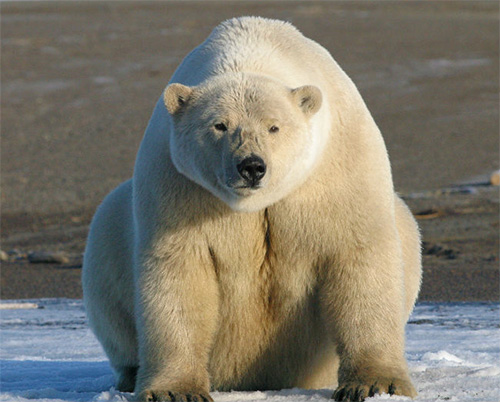
How to conserve polar bears under climate change and maintain subsistence harvest
March 16, 2017
Research from the University of Washington, the U.S. Fish and Wildlife Service and the U.S. Geological Survey investigates what these changes could mean for subsistence harvest of polar bears -- a practice that has cultural, nutritional and economic importance to many Northern communities. An open-access study published this month in the Journal of Applied Ecology addresses this question using an improved model of how polar bear populations function.
Polar Bear on shore.
The authors identify ways to maintain subsistence harvest without compounding the negative effects of habitat loss, as long as there is accurate population data and the harvest is responsive to changes in the environment. "A key takeaway is that, under many conditions, it is possible to identify a rate of harvest -- the fraction of a population to be removed each year -- that doesn't drive down the population or accelerate any potential population declines due to habitat loss," Regehr said. Currently there are about 26,000 polar bears divided into 19 subpopulations across the Arctic, two of which occur partially in Alaska. The species was listed as threatened throughout its range under the U.S. Endangered Species Act in 2008 due to observed and projected loss of sea-ice habitat due to climate change. "The current status of the 19 subpopulations in relation to climate change is variable. Some are declining or exhibiting signs of stress," Regehr said. "Because of regional variation in environmental conditions and ecology, some subpopulations are stable or may be increasing." But the sea ice trend is clear. A recent UW-led study showed all 19 subpopulations are seeing the effects of an earlier spring ice melt and later fall freeze-up, and that from 1979 to 2014 polar bears lost an average of seven weeks on the sea ice. This trend toward shorter ice-covered periods is expected to continue, and in the long term is anticipated to negatively affect polar bears throughout most of their range. In the new study, researchers combined the polar bear population model with projections for future sea ice extent provided by co-author Harry Stern in the UW's Applied Physics Laboratory. Results show that, with the right approach, subsistence harvest can likely continue without putting subpopulations at additional risk. "When habitat loss causes crowding, there are generally negative effects on animals such as lower nutritional condition, reproduction and survival," Regehr said. "If a well-designed harvest can reduce this crowding, there's more ecological space for animals to feed, and as a result more cubs can be born." The study finds that as climate shifts it becomes increasingly important to monitor each subpopulation regularly, through scientific studies and collection of local knowledge, and adjust harvest accordingly. This strategy, known as "state-dependent management," is becoming popular for other wildlife species that live in changing ecosystems. "If environmental conditions are changing fast, it's important to have more frequent population assessments, so you don't go for a long time with a harvest that used to be OK but eventually becomes unsustainable," Regehr said. "In the absence of good information about a subpopulation, you generally have to take a more conservative approach." Regehr has spent the past 15 years studying polar bears for the U.S. Department of the Interior. For the past eight years he has led research on the Chukchi Sea subpopulation, which is shared between the U.S. and Russia. Regehr is also the American co-chair of the scientific advisory group under a treaty between the two countries intended to conserve this shared subpopulation. He will continue to study polar bears and wildlife management in his new position as a researcher with the UW's Polar Science Center. Funder: NASA, US Fish and Wildlife Service, US Geological Survey On the Web:
Editing by Mary Kauffman, SitNews Source of News:
Representations of fact and opinions in comments posted are solely those of the individual posters and do not represent the opinions of Sitnews.
|
||
